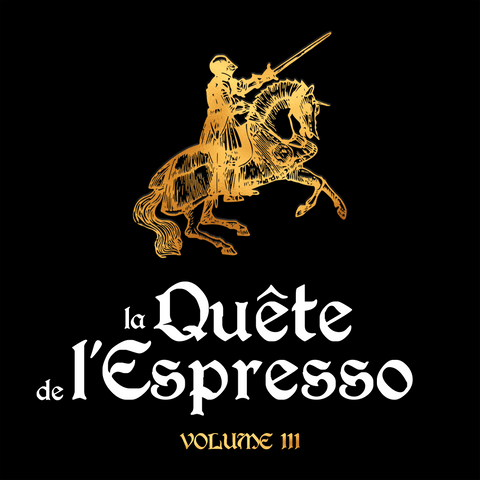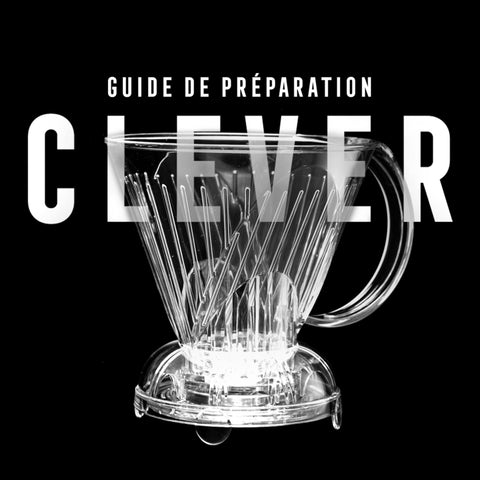
Or to listen to it in podcast version on Apple podcast: Building the framework - The dose
I hesitated for a long time over the choice of the first parameter that I was going to discuss with you.
The grind seemed the most important element to me and I was about to start writing when I received a text from a friend who told me that he had bought a great espresso machine and that he wanted me to helping him with his grip, because he didn't know where to start.
We arranged to meet up to chat and I gave him express training on what he needed to know and where he should focus his attention. And after he left, I sat back down to work on the episode content on the grind and realized that the order in which I had covered the information for my friend was exactly how I should present the information in my series.
I actually told him about the grind, which is a most important element, but that element came after several other points. Which then changed my plan for episode 3 of the Quest for Espresso series.
I am still convinced that the grind is a major element in the preparation of an espresso, but given the multitude of parameters to adjust, we must set a precise framework for the preparation before attacking the elements which will be more difficult to adjust.
And when I did my express training to my friend, the first thing I told him was that you need to fix the frame of your espresso.
What I mean by this is to define the dose of coffee, and your ratio. Afterwards, you work on preparing your dose, including the grind level, the distribution of coffee in the basket, and so on.
Once the framework is in place, the grind adjustment will be more significant and the influence on extraction much more obvious.
The grind will then become the only variable element in the equation.
All other parameters will have been fixed.
And when the material is well understood, we can go back and modify a parameter of the framework, to come back with the adjustment of the grind.
So this is a method that I suggest to you.
And this episode will focus on the first element which will allow the first point of definition of the framework, namely “The Dose”.
We must understand that the great difficulty of preparing an espresso comes from the fact that we must adjust and control more parameters. And if we cannot fix the majority of the parameters, there will then be too much unknown in the equation, and we will then leave it to chance to intervene.
The idea is really to set all the parameters to eliminate the chance of preparation as much as possible.
So, let's start by discussing the dose, the amount of ground coffee you are going to put in the filter holder basket.
This dose will influence the resistance that the water will encounter, and this resistance will be more or less amplified by the fineness of the grind. It is therefore the dose which determines the adjustment of the grind.
In the next episodes, we will discuss the notion of ratio, the famous grinding and temperature. As for the extraction time, I will talk about it a little, but it is more a result of the adjustment of the parameters and as it depends on the ratio, it will especially be the flow rate which will be important to check and in the end total contact time.
Now for the dose, let me backtrack with a little explanation of what happens during the preparation.

What we want to do is extract the soluble elements from a quantity of coffee using hot, pressurized water, to transfer everything that the water can absorb into a cup.
The goal is to get as much of the delicious aromas out of the ground coffee as possible, and the more you extract, the better.
In theory, roasted coffee is around 28% soluble in water. Which means that under optimal conditions, we can extract 28% of the mass of ground coffee to transfer it to water.
The remaining 72% is cellulose, the plant structure of the coffee bean.
Water is a very good medium for extracting coffee, but it needs a little help. If you soak coffee beans in water, you won't get much.
The structure of the coffee bean, which is actually the core of the fruit, is very dense. Water cannot pass through to collect soluble elements, as is done with tea leaves for example.
We must then increase the contact surface, by opening the bean to let the water pass through.
And this is why we put the coffee beans through the grinder.
By splitting the bean, we increase the contact surface between the water and the coffee.
In an ideal world, we would only have to grind the grain, bathe it in water, and we would obtain a perfect beverage.
Unfortunately, it's not that simple because not all of the soluble elements in coffee are enjoyable.
Extraction must be controlled to limit the transfer of desired elements to ensure a pleasant cup.
And we have to be careful, because if we prolong the extraction too long, we will end up with less pleasant elements in the cup.
We can measure the portion extracted and transferred to the water, which we express as a percentage.
If we used 18g of ground coffee, a percentage of that 18g will be transferred into the cup. It is possible after preparation to dry the coffee cake, and weigh it to see what weight will have disappeared. In the laboratory, we will use refractometers which make it possible to measure it more easily and quickly.
In the context of your cooking, it is above all the result of the cup that is important. Is it good or not.
As for the dose, the quantity of ground coffee allows us to define how many soluble elements we will send into our cup.

I mentioned the figure of 28% in an ideal environment, and this includes the extraction of less interesting elements in terms of taste.
For espresso, the target is between 18% and 22%.
Which means that on a dose of 18g of ground coffee, at 20% you will have 3.6g to transfer into the water.
So, on a 36ml espresso we will have a strength of 3.6g / 36g = 10%
I don't want to lose anyone with the numbers, but the dose of coffee chosen will influence the amount of soluble material available to transfer into the cup.
And subsequently, the amount of water that passes through the grind, or that is added subsequently as in the case of an Americano, will influence the strength of the final brew.
The strength of the Espresso is therefore the percentage of what has been transferred to the total quantity of water. Usually, we will be between 7% to 12%.
Which means we have 88% to 93% water in the cup.
In the case of filter coffee, we are around 1.2 to 1.8%, which gives us a water content of 98.2 to 98.8%.
Coming back to the dose of ground coffee for espresso, we could simply add more to obtain more extracted elements, but we then encounter physical and technical constraints which come from the design of the equipment.
Because extracting larger quantities requires a lot of work from the machines. And the vast majority of equipment is designed to extract pre-established quantities between 9g and 20g.
As for residential machines, the majority of machines work well around 14-18g. This of course depends on the design.
What limits us in the possibilities and it is the quality of the equipment which determines how far we can increase a dose of coffee.
I'm skipping the mill's contribution here, but a larger dose requires near-perfect grinding with grain splitting containing the minimum amount of dust, and maximum uniformity.

It is therefore your machine which will determine your dose, and particularly the basket of your filter holder.
By the way, it is possible to change your basket to work with different doses, but each basket is designed for a specific dose. Sometimes it is listed on the basket, other times it is not, so you may need to do a little research on your equipment to know the ideal dose, or at least the maximum dose.
Note that it is possible to use less coffee, for example putting 14g in an 18g basket.
The only downside to using less coffee than the recommendation is that it can be a little messy.
If you use less coffee, the distance between the surface of the wafer and the machine nozzle from which the water will come out will be greater.
And when the extraction stops, and the pressure dissipates rising through the head, a mini vortex will occur inside the basket which will break the coffee cake. You will then be able to observe a muddy-looking cake which will be difficult to remove by simply hitting the filter holder on a knock-box.
Note that this mini vortex will not occur if the distance between the surface of the ground coffee and the shower head remains close enough. And it will be easy to remove the coffee wafer by hitting the knock-box.
It is for this reason that the baskets identified for a dose of 14g are lower than the 18g.
So, a muddy or dry cake has nothing to do with the quality of the extraction, but indicates that the size of the basket is optimal for the chosen dose when you obtain a nice dry cake which is easily removed and does not bother you. All that remains is to quickly wipe the inside with a dry cloth in preparation for the next dose.
So, pay attention to the size of the filter holder basket and check with the manufacturer's information if it is not clear.
Traditionally, the baskets of espresso machines were designed for doses of 14g, which were called "double" or 7g to 9g for small ones in single espresso.
I will return to this subject in the ratios episode, because the notion of single and double creates a lot of confusion, with good reason.
It is therefore very possible to have a delicious espresso with a dose of 14g.

The popularity of 18g to 22g doses comes from baristas who wanted to gain speed and who filled the baskets completely, leveled with their fingers and pressed the cake, often inventing almost esoteric styles and methods.
The use of a manual dosage mill limited the level of uniformity of the doses used and by completely filling the basket, we managed to have a fairly similar dose from one preparation to another.
And with the arrival of volumetric grinders on demand, it is possible to dose ground coffee much more precisely and quickly.
And today, the majority of professionals use this type of grinder, a tool for properly distributing coffee, and a coffee cup.
Of course you can make great higher doses, but not all machines can do it.
If I go back to the previous information, the dose of coffee that your basket will allow will give you a limited amount of extract in the cup.
So the longer you make your espresso, the more diluted it will be. A dose of 20g will then make a delicious 50ml espresso, while a dose of 14g can go up to 40ml. We can of course go further, but we will dilute the drink further.
And at a certain point, espresso-style extraction will no longer be the right medium for preparing coffee, and it would be better to use filter percolation or a full-immersion method.
To summarize this part, the dose of coffee you use will be determined by your equipment, particularly the size of the portafilter basket.
Espresso is not better with a larger dose.
Then the dose can be determined by how much of the extracted brew you want while still maintaining good strength in the brew. The more water you add, the more it will be diluted.
The other factor that will determine the amount of coffee is the coffee itself. Basically, the darker the coffee is roasted, the easier it will be to extract the soluble elements. So if you want to use a larger dose with a home machine, you will get an espresso with more strength than with a light roast.
Dark roasting breaks up the structure of the bean, making extraction easier. On the other hand, it tastes what it tastes like.
With a lighter roast, extraction will be more difficult and you will see the limitations of the machine. And for very high altitude, very dense coffees, it will be even more marked.
If the roast is really light, espresso is not the ideal medium and you will always get a weak, sour, very vegetal, bitter beverage, etc. In short, nothing pleasant.
Note that a commercial machine of high technological quality can get the most out of a lightly roasted coffee, but that with a residential machine, certain coffees should be avoided.
All this if we consider using the same dose.
You can use a smaller dose with light roast coffees, which will be easier on the machine and you will be able to get some little wonders out of it.
Remember that you will need to keep your extractions fairly short to stay within an interesting strength spectrum.
But what I strongly advise you is to determine the ideal dose for your equipment and to work with a fixed dose.
If you are at 14g, plan your extractions with 14g of coffee.
With a dose of 14g, extracting at a ratio of 1:2 will give you 28g of liquid.
1g of water = 1ml of water, let's say we stretch it a little from 28ml to 30ml and we get a classic 1oz espresso.
Out of the 14g of ground coffee, let's say you managed to extract 18% of the dose, then you transfer 2.52g into your cup.
And on the 30g cup, 2.52g equals 8.4% strength.
And by adjusting the grind correctly, and if there is no channeling in the coffee mass, a flow rate of 1ml per second will give you an interesting result.
So your recipe could be:
14g at the entrance
30g at the exit
in 25-30 seconds.
Which gives you an interesting recipe.
In short, it is possible to change the dose, but I strongly recommend, especially during your exploration of this method, to keep it as stable as possible.
By doing this you simplify the equation.
A brief overview of the notion of grinding, with a fixed dose, it is the size of the coffee particles which will mainly influence the resistance that the water will encounter. Make sure you have the same dose and adjust your grinder to get the right flow rate.
With 14g, obtaining 30g of liquid in 25 seconds, or 35 seconds, could give you a completely different beverage, possibly causing you to miss the perfect extraction.
This is also what makes espresso so addictive, this quest, this obsession with having perhaps missed the ultimate enjoyment of one too many grinders, or of one gram of coffee that would have been retained. between the millstones.
It's enough to drive you crazy or fall in love with a delicious hobby.
And I forgot to tell you that a scale is an essential element for properly controlling your preparations.
I think I've covered the subject.
Next episode we will talk about the concept of ration, and I will explain to you why the concept of single and double should not be used.
Until then, I invite you to contact me if you have any questions or comments or if you want me to address a specific point for future episodes.

Dany Marquis




Comments (3)
Merci pour l’article. En france on est habitué dans les bars/restaurants a des cafés plus dilué. On a en tasse un café de 35ml, mais ils ne mettent pas 18g de café. Peut-être 7, soit un ratio de 1:5. Ces cafés sont certe plus léger mais je ne les trouve pas si mauvais ou dilué après un repas. Ou est ce que je me trompe ? Comment reproduire les cafés de restaurants ? Merci
Simplement pour vous dire que j’ai adoré votre article. Depuis toujours je fais mes expresso de façon plus “sentie” en finissant par savoir ce qui marche ou non, mais souvent à recommencer lorsqu’on change de café. En se donnant ce cadre d’analyse, ca va me permettre de davantage objectiver mes extractions et de mieux comprendre ce qui se passe. Un grand merci de partager votre savoir!!! J’aurais peut-être une question bonus pour vous. Je ne bois que des lattés avec ma machine, est-ce qu’il y a des rations standards usuels de quantité de café versus quantité de lait ou c’est plutôt une question de goût (tout reste question de goût, mais des standards, ca fait de bons points de départ! ;) Merci encore.
Vincent
J’aimerais que vous parliez de la température de l’eau et son influence sur l’extraction.